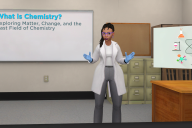You have /5 articles left.
Sign up for a free account or log in.

Istockphoto.com/NicoElNino
Students at six U.S. and six Japanese institutions next fall will get to enroll in classes developed jointly by instructors from opposite ends of the globe, thanks to a new technology-enhanced collaboration funded by the two countries’ governments.
The American Council on Education is facilitating the American end of the project, which will spur implementation of a pedagogical method known as Collaborative Online International Learning (COIL), developed at the State University of New York in the early 2000s and now in use at dozens of institutions around the world.
Participating U.S. Institutions (and Japanese Partners)
DePaul University (Nagasaki University)
James Madison University (Kansai University)
CUNY College of Staten Island (Partner pending)
Sinclair Community College (J. F. Oberlin University)
University of Alabama (Chiba University)
University of Wisconsin La Crosse (Kagoshima University)
Each American institution in the ACE program will have a corresponding Japanese partner institution. Instructors from both countries will collaborate to develop syllabi for courses that expose students to international perspectives and connect them to students in the opposite country.
Thus far Japan's government has committed $2.5 million for the first year of COIL programs with the U.S. and others, with more to come, while the U.S. Embassy Tokyo has contributed approximately $271,000 for the first two years of the Japanese collaboration, including some funds to support institutions that didn't make the cut for the full program.
“This is a rare opportunity to have bilateral governmental support for digital exchange for students,” said Veronica Onorevole, senior program specialist at ACE’s Center for Global Engagement (CIGE). “We felt it was important, and hopefully it’s a starting point for more engagement of this nature to gain access to global learning opportunities for their students.”
The grant program was born after Japanese officials reached out to ACE in spring 2016 to brainstorm about educational collaborations. A “very strong” COIL center already exists in Osaka, making a cross-country learning exchange “cost-effective, highly accessible and scalable,” said Heather Ward, associate director of CIGE.
The COIL method offers instructors a model for project-based, collaborative learning environments -- either online, face-to-face or some combination of the two -- in which students from different cultures gain a "deeper understanding of ideas and texts" and develop "cross-cultural competence," with plentiful opportunities for student interaction and idea exchange. Its appeal, according to Ward and Onorevole, is in its flexibility.
“It is not a technology. It’s not a software. It’s not a platform,” Ward said. “It’s purely a pedagogical approach.”
COIL emerged around 2004 when a professor at the State University of New York at Purchase returned from a stint abroad and decided to maintain his new international connections by co-teaching a course remotely, according to Mary Lou Forward, executive director of SUNY’s COIL Center, which opened at Purchase in 2006 and moved to the SUNY system's office of global affairs in 2008.
“It’s not about professors in one country giving lectures in the same subject in another country, although that happens,” Forward said. “It’s trying to get students to apply their learning with a cross-cultural communications component where they need to think beyond the subject matter.”
Representatives of Forward’s center offered a workshop to participants in the U.S.-Japan program in Washington last month. They’ll also offer additional training and guidance as course development takes off, Forward said.
International collaborations don’t have to result in identical courses on each campus, as long as the group projects serve the curriculum for each. One example offered during last month’s workshop was a criminology course in one country teaming up with a photography course in the other, with students passing along crime-scene photos.
Twenty-seven institutions applied earlier this year for six slots. ACE prioritized campuses from a variety of locations and contexts, even making room for a two-year institution -- Sinclair Community College in Ohio, one of four two-year institutions that applied.
Qualifications included plans to assess outcomes of the project and a long-term road map for sustaining the partnership beyond the term of the initial collaboration. Institutions that included an in-person study abroad component got bumped up in consideration, according to ACE.
For Sinclair, the grant represented a rare opportunity to change the fact that “probably 98 percent of our students will never study abroad,” said Deborah Gavlik, director of Sinclair’s International Education Office.
More from "Inside Digital Learning"
Research on digital learning faces uncertain future as funding tightens and approaches differ.
What's next for institutional and system organizations supporting technology-enabled instruction.
Sony unites forward-thinking institutions for collaborative dialogue and product testing.
Institutions applying for the ACE program could bring an existing Japanese partner or pair up with one of the collaborative program’s participants. Sinclair opted for the latter. An art history instructor at Sinclair, along with Gavlik and an elearning division representative, will team up with an instructor at J. F. Oberlin University in Tokyo to create a course structure and assignments.
As of now, the rough plan is for an existing architecture course at Sinclair to culminate with groups of students from both countries collaborating on examining the work of either Frank Lloyd Wright or a similarly prominent Japanese architect. Students will communicate on a platform that’s already familiar to the university, such as Facebook Messenger or Zoom, according to Gavlik.
DePaul University, on the other hand, has been engaging in collaborative learning across borders with numerous countries for years. The ACE program will help the institution makes its first foray into Japan, according to GianMario Besana, associate provost for global engagement and online learning.
Two faculty members have already started working with instructors at Nagasaki University on an atomic bomb course and an upper-level Japanese translation course. Each will have some synchronous components for students in the two cohorts, as well as asynchronous discussion boards and peer editing throughout the semester.
Early data from student experiences in COIL courses suggest that students come away with a more open-minded view of global affairs. The question of whether students are retaining information and learning more deeply remains to be answered, Besana said.
Logistical challenges also have to be ironed out. One DePaul instructor lost touch with his counterpart from India for over a week, only to find out later that instructors there tend to take off work for Diwali, the annual festival of lights. DePaul instructors now spend two and a half weeks in training before collaborating outside the institution, according to Besana.
As COIL takes hold at more campuses, the center at SUNY hopes to find ways to grow its footprint. Next year it will host the first annual International Virtual Exchange Conference in Seattle. The goal is to help as many institutions as possible see the potential in getting together.
“Most people are using [technology] as a way to organize and not necessarily the way to engage,” Forward said. “We need to harness technology as a tool, not as the end goal, to engage students in the application of learning.”







